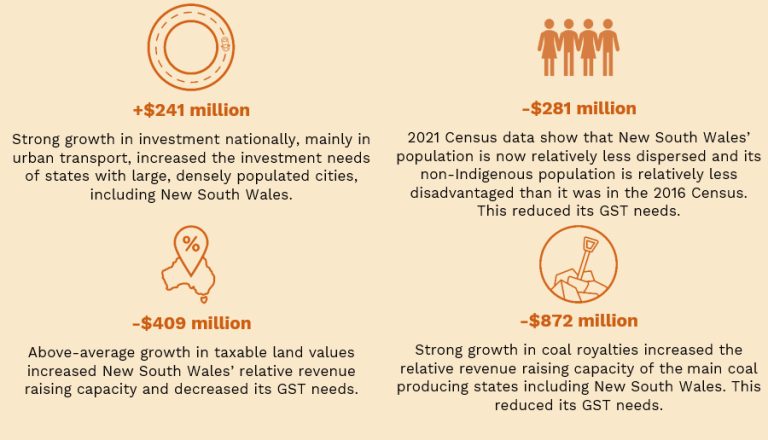New South Wales
In this snapshot
New South Wales is estimated to receive $24,224 million in GST in 2024–25. This would be a decrease of $310 million compared with 2023‑24. The change reflects New South Wales’ assessed needs for GST and its share of the growth in the GST. It also reflects the application of the 0.75 GST relativity floor, which increases the GST distributed to Western Australia and reduces the GST distributed to all other states.
GST distribution in 2024-25

Key factors that changed New South Wales’ GST needs in 2024-25 compared with 2023-24

How New South Wales compared with other states and territories
New South Wales’ capacity to raise revenue from its own taxes is greater than the national average. For example:
The characteristics of the people and services in New South Wales means that the cost of providing government services is below the national average. For example:
Overall, with a below-average cost of providing services and an above-average revenue raising capacity, New South Wales receives a per person GST distribution less than the national average.
How the GST is distributed
The Commonwealth Grants Commission provides independent advice to the Australian Government on how GST should be distributed among the states. In doing this, the Commission takes account of states’ different abilities to raise revenue and their different costs in providing services.
The amount of revenue each state can raise differs because it depends on things like the value of mining production, property transactions and taxable payrolls. The cost of providing services varies too, based on things like a state’s size, its geography, where its residents live and other socio-demographic characteristics, for example, age, health, income, and education.
Changes to the GST distribution in 2024–25 reflect the 2018 GST legislated arrangements. These include implementation of a GST relativity floor below which no state’s GST revenue sharing relativity can fall and Commonwealth top-ups to the GST pool. The Commonwealth also makes separate transitional no worse off payments to the states.
